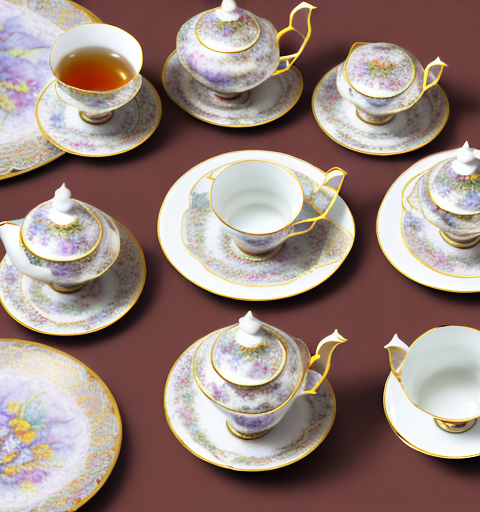Tea stains can be a common problem when it comes to maintaining a clean ceramic teapot. The build-up of tea residue in the spout filter not only affects the appearance but can also impact the taste of your brew. In this article, we will explore the importance of keeping your ceramic teapot clean, discuss the materials needed for tea stain removal, and provide simple steps to help you restore your teapot to its former glory. Additionally, we will delve into natural cleaning solutions, such as vinegar and baking soda, lemon juice, and hydrogen peroxide. We will also touch on the benefits of using specialized teapot cleaning products, share tips and tricks for preventing future stains, and provide guidelines for cleaning and maintenance. Lastly, we will address common issues encountered during the tea stain removal process and offer expert advice on how to restore the shine and luster to your ceramic teapot filter.
Understanding the importance of maintaining a clean ceramic teapot
A clean ceramic teapot not only looks appealing but also ensures the best possible taste for your tea. Over time, tea stains can accumulate in the spout filter, affecting the flavor of your brew. Moreover, neglected stains can also lead to the growth of bacteria or mold, posing potential health risks. Regular cleaning and maintenance are therefore crucial to maintaining a pristine teapot while enjoying a delightful cup of tea.
In addition to affecting the flavor and potentially posing health risks, a dirty ceramic teapot can also impact the overall brewing process. Tea stains and residue can clog the spout filter, hindering the flow of hot water and affecting the steeping time. This can result in an uneven extraction of flavors and a less satisfying cup of tea.
Furthermore, a clean teapot is essential for preserving the longevity of the ceramic material. Tea stains can penetrate the porous surface of the teapot, causing discoloration and weakening the structure over time. Regular cleaning not only keeps your teapot looking pristine but also helps to maintain its durability and extend its lifespan.
The common problem of tea stains in the spout filter
The spout filter of a ceramic teapot is particularly susceptible to tea stains due to its shape and exposure to the brewing process. The repeated pouring of tea through the filter can cause tannins and other compounds to accumulate, resulting in unsightly stains. However, with the right materials and cleaning methods, you can effectively tackle this issue and restore your teapot’s filter to its original condition.
One effective method for removing tea stains from a ceramic teapot’s spout filter is to use a mixture of baking soda and vinegar. Start by dampening a soft cloth or sponge with vinegar and gently scrub the stained areas. Then, create a paste by mixing baking soda with a small amount of water. Apply the paste to the stains and let it sit for a few minutes before scrubbing again. Rinse the filter thoroughly with water to remove any residue. This natural cleaning solution can help break down the tea stains and restore the filter’s cleanliness.
Materials needed for removing tea stains from a ceramic teapot
Before diving into the steps of tea stain removal, gather the necessary materials. You will need a soft brush or sponge, mild dish soap, vinegar, baking soda, lemon juice, hydrogen peroxide, specialized teapot cleaning products, and soft cloths. These materials will assist you in effectively removing tea stains without causing damage to your teapot.
Additionally, it is recommended to have a small bowl or container to mix cleaning solutions, a toothbrush for scrubbing hard-to-reach areas, and a microfiber cloth for polishing the teapot after cleaning. The small bowl or container will allow you to easily combine the cleaning agents and create a powerful stain-removing solution. The toothbrush will help you scrub away stubborn tea stains in crevices or corners of the teapot. Finally, the microfiber cloth will give your teapot a shiny finish and remove any remaining residue.
Furthermore, if you prefer using natural cleaning methods, you can also consider using white vinegar, lemon juice, or baking soda individually as alternative cleaning agents. These natural ingredients are effective in breaking down tea stains and are safe to use on ceramic teapots. However, it is important to note that natural cleaning methods may require more time and effort compared to using specialized teapot cleaning products or commercial stain removers.
Simple steps to remove tea stains from the spout filter of a ceramic teapot
Now that you have your materials ready let’s explore the steps to remove tea stains from the spout filter of a ceramic teapot. Please note that these steps may vary depending on the severity of the stains and the specific teapot model. Always refer to the manufacturer’s instructions if available.
1. Start by rinsing your teapot with warm water to remove any loose debris.
2. Create a cleaning solution by combining mild dish soap and warm water in a bowl or basin.
3. Soak the soft brush or sponge in the cleaning solution, ensuring it is thoroughly saturated.
4. Gently scrub the spout filter of the teapot in circular motions, paying close attention to the stained areas.
5. Rinse the teapot under warm water to remove the soapy residue.
6. If the stains persist, it’s time to explore natural cleaning solutions.
7. One natural cleaning solution you can try is using a mixture of baking soda and water. Create a paste by combining equal parts of baking soda and water in a small bowl.
8. Apply the baking soda paste to the stained areas of the spout filter and let it sit for about 15 minutes.
Exploring natural cleaning solutions for tea stain removal
Natural cleaning solutions are a great alternative to harsh chemicals and can be effective in removing tea stains. Vinegar and baking soda, lemon juice, and hydrogen peroxide are some commonly used household items that can work wonders when it comes to cleaning your teapot.
Another natural cleaning solution that can be used to remove tea stains is salt. Salt has abrasive properties that can help scrub away stubborn stains. Simply sprinkle some salt onto the stained area, dampen a cloth or sponge with water, and gently scrub the stain in a circular motion. Rinse the teapot thoroughly with water afterwards to remove any residue.
The effectiveness of vinegar and baking soda in removing tea stains
Vinegar and baking soda are gentle yet powerful cleaning agents that can help lift stubborn tea stains from your teapot filter. Create a paste by mixing equal parts of vinegar and baking soda, then apply it to the stained areas. Let the paste sit for a few minutes before using a soft brush or sponge to gently scrub the stains. Rinse thoroughly with warm water, and repeat the process if necessary. The acidic properties in vinegar and the abrasive action of baking soda can work together to dissolve and remove tea stains effectively.
In addition to their stain-removing properties, vinegar and baking soda also have other benefits when it comes to cleaning. Vinegar is a natural disinfectant and can help eliminate bacteria and odors, while baking soda acts as a deodorizer and can absorb unpleasant smells. So, not only will using vinegar and baking soda help remove tea stains from your teapot filter, but it will also leave it clean, fresh, and ready for your next cup of tea.
Using lemon juice as an alternative method for removing tea stains
Lemon juice, with its natural acidity, can also be an effective solution for tea stain removal. Squeeze fresh lemon juice onto a soft cloth or sponge and gently rub it onto the stained areas. Allow the juice to sit on the stains for a few minutes, then rinse the teapot thoroughly with warm water. Lemon juice not only helps to remove the stains but also leaves a fresh and citrusy aroma.
In addition to its stain-removing properties, lemon juice can also be used to brighten and restore the shine of tea-stained teapots. After applying the lemon juice to the stains, use a clean cloth or sponge to gently buff the surface of the teapot. This will help to remove any remaining residue and bring back the teapot’s original luster.
It’s important to note that lemon juice may not be suitable for all types of teapots, especially those made of delicate materials such as bone china or porcelain. Before using lemon juice on your teapot, it’s recommended to test it on a small, inconspicuous area to ensure that it doesn’t cause any damage or discoloration.
How to use hydrogen peroxide to tackle stubborn tea stains in a teapot filter
For particularly stubborn tea stains, hydrogen peroxide can be a helpful ally. Dilute hydrogen peroxide with water, using a ratio of 1:1, and soak the affected parts of the teapot in the solution. Allow it to sit for a few hours or overnight. Afterward, rinse the teapot thoroughly with warm water. Hydrogen peroxide’s oxidizing properties can aid in breaking down and removing even the most resistant tea stains.
It is important to note that hydrogen peroxide should be handled with care. Always wear gloves and avoid contact with your skin or eyes. Additionally, make sure to use hydrogen peroxide in a well-ventilated area to avoid inhaling fumes.
If the tea stains are still persistent after using hydrogen peroxide, you can try using a mixture of baking soda and water. Create a paste by mixing equal parts of baking soda and water, then apply it to the stained areas of the teapot filter. Gently scrub the stains with a soft brush or sponge, and rinse thoroughly with warm water. Baking soda’s abrasive properties can help lift and remove stubborn tea stains.
Explaining the benefits of using specialized teapot cleaning products
Specialized teapot cleaning products are specifically formulated to tackle tea stains and maintain the integrity of your teapot. These products often contain gentle yet effective ingredients that can penetrate and dissolve stains without causing damage. They are convenient to use and can provide excellent results. Follow the instructions provided by the manufacturer when using these products to ensure optimal performance.
Using specialized teapot cleaning products can also help prolong the lifespan of your teapot. Regular cleaning with these products can prevent the buildup of residue and mineral deposits, which can affect the taste and quality of your tea. Additionally, these products are designed to be safe for use on various materials, such as ceramic, porcelain, and glass, ensuring that your teapot remains in pristine condition. Incorporating specialized teapot cleaning products into your cleaning routine can help you maintain a clean and well-functioning teapot for years to come.
Tips and tricks for preventing future tea stains in your ceramic teapot filter
Prevention is key when it comes to minimizing the occurrence of tea stains. Here are a few tips to help you keep your ceramic teapot filter stain-free:
– Rinse your teapot with warm water immediately after each use to remove any residual tea.
– Avoid soaking the teapot filter for extended periods, as this can lead to the accumulation of stains.
– Regularly clean and maintain your teapot to prevent the build-up of tea residue.
– Use a soft brush or sponge dedicated to teapot cleaning to ensure proper hygiene.
– Consider using a tea strainer or tea bag to minimize direct contact between the tea leaves and the teapot’s spout filter.
– Additionally, you can try using a mixture of baking soda and water to gently scrub away any stubborn tea stains on your ceramic teapot filter. Simply create a paste by mixing equal parts baking soda and water, apply it to the stained areas, and let it sit for a few minutes before rinsing it off. This natural cleaning method can help remove stains without damaging the ceramic surface.
Cleaning and maintenance guidelines for a pristine ceramic teapot spout filter
To maintain a pristine ceramic teapot spout filter, follow these general cleaning and maintenance guidelines:
– Clean your teapot thoroughly after each use.
– Pay special attention to the spout filter when cleaning, ensuring no stains are left behind.
– Regularly inspect the teapot for any signs of damage or wear.
– Avoid using abrasive cleaners or harsh chemicals that could scratch or damage the teapot.
– Store your teapot in a dry and clean environment to prevent the growth of mold or bacteria.
– Follow the manufacturer’s instructions for any specific recommendations regarding your teapot’s cleaning and maintenance.
– It is recommended to use a soft brush or cloth to clean the ceramic teapot spout filter, as this will help to remove any residue or buildup without causing damage.
Troubleshooting common issues encountered during the tea stain removal process
Despite your best efforts, you may encounter some common issues during the tea stain removal process. Here are a few troubleshooting tips:
– If the stains persist after using a natural cleaning solution or specialized products, repeat the process or consider seeking professional cleaning assistance.
– If the teapot filter becomes damaged during the cleaning process, consult the manufacturer or consider replacing it to ensure optimal functionality.
– Be cautious when using abrasive tools to scrub stains, as they can scratch or damage the teapot’s surface.
– If you notice any discoloration or changes in the appearance of the teapot’s material after cleaning, it is recommended to test the cleaning solution on a small, inconspicuous area before applying it to the entire teapot. This will help prevent any potential damage or adverse reactions to the material.
Expert advice on restoring the shine and luster to your ceramic teapot filter
If you want to restore the shine and luster to your ceramic teapot filter, consider the following expert advice:
– After removing the tea stains, rinse the teapot thoroughly to remove any residual cleaning agents.
– Use a soft cloth to gently dry the teapot, ensuring no water spots or stains remain.
– Polish the teapot’s surface with a clean and dry cloth to bring out its natural shine.
– Store your teapot in a safe place to prevent any accidental damage.
By following the guidelines outlined in this article, you can successfully remove tea stains from the spout filter of your ceramic teapot, ensuring a clean and enjoyable tea brewing experience. Regular cleaning and maintenance, along with the use of natural cleaning solutions or specialized products, will help you maintain the pristine condition of your teapot for years to come. So, grab your cleaning materials and embark on the journey to restore your teapot’s shine and say goodbye to those pesky tea stains!
Additionally, it is important to note that using abrasive cleaning tools or harsh chemicals can damage the surface of your ceramic teapot filter. Stick to gentle cleaning methods and avoid scrubbing too vigorously to preserve the integrity of the filter. If you are unsure about the best cleaning method for your specific teapot, consult the manufacturer’s instructions or seek advice from a professional.






